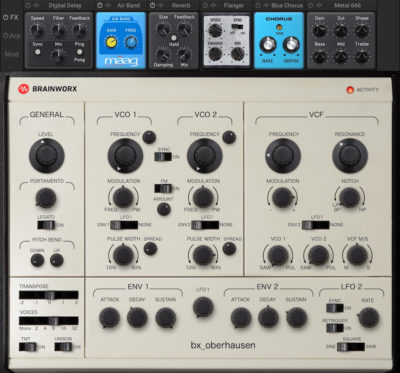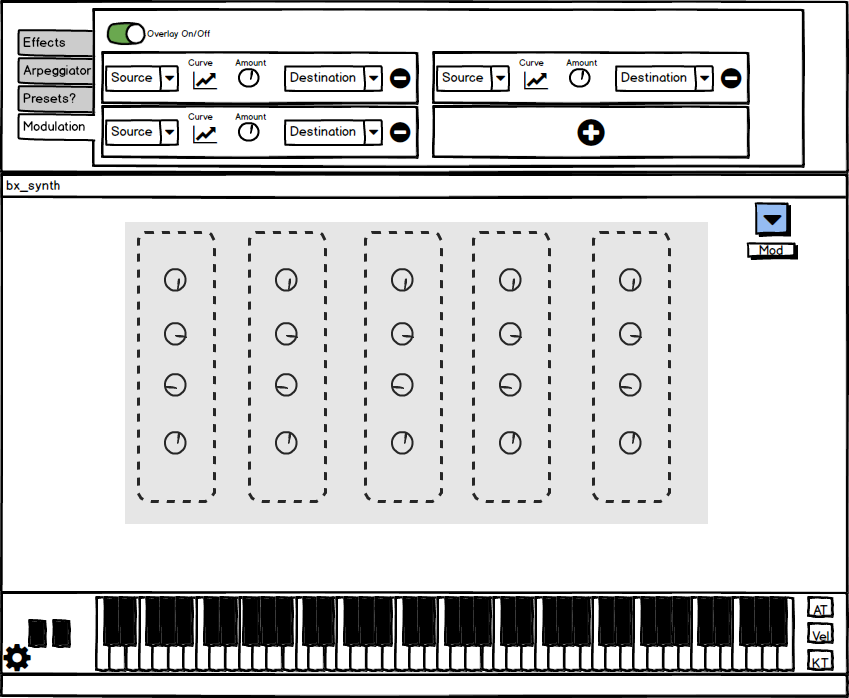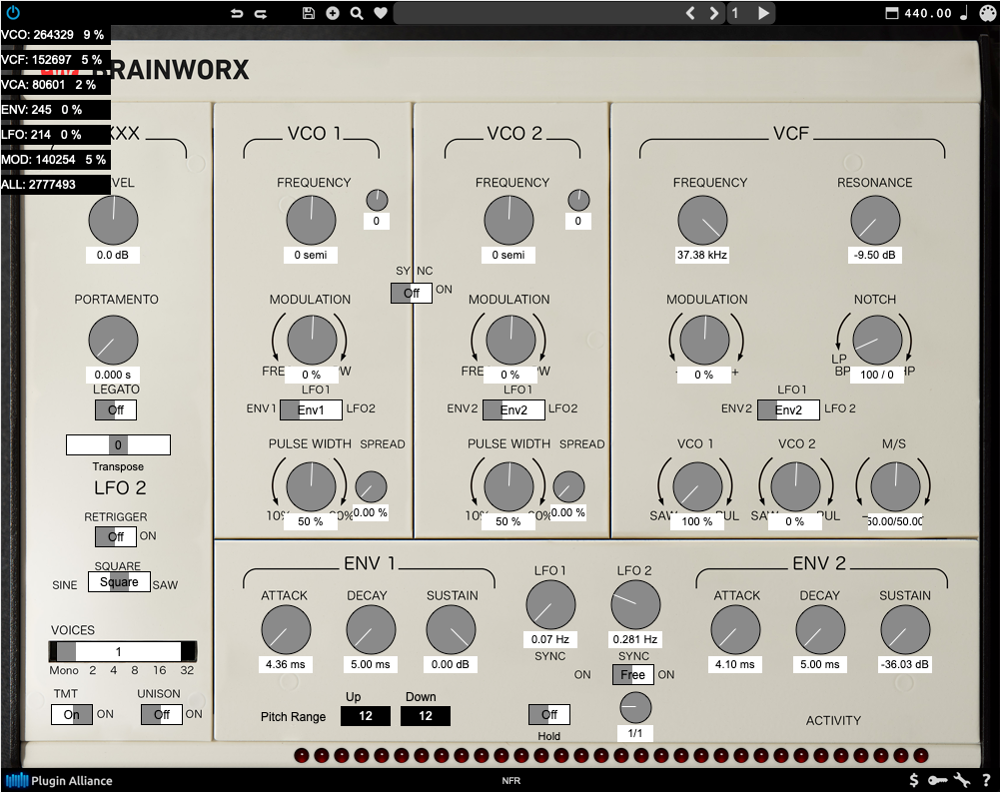Research & Development: How Brainworx Broke Through to Virtual Instruments with bx_oberhausen
There’s a first for everything.
Devising mixing and mastering plugins had become second nature for the prolific developer Brainworx. After 10+ years of making an impact in that arena, however, the creators of myriad solutions including the bx_console series, bx_masterdesk, and classic (and free!) bx_solo out to challenge themselves anew.

bx_oberhausen marked Brainworx’ first foray into virtual instruments — and a host of complex decisions along with it.
The result wasn’t just a different plugin, but a different vertical: the bx_oberhausen, an analog synth module that stands as their first VI (virtual instrument). Most likely inspired by the revered Oberheim SEM (Oberheim’s first analog synth) which featured fully analog, discrete circuits and a classic state-variable 2-pole filter, the bx_oberhausen provides composers and producers with full polyphony of up to 32 voices and includes Plugin Alliance’s TMT (Tolerance Modeling Technology), a technique that endows modelling plugins with the same variations caused by component tolerances in actual hardware.
Other highlights include Unison mode for a complex and authentic analog sound, along with what Brainworx calls “Virtual vitamin” boosting that brings Mid/Side (M/S) technology to a soft synth.
In this latest “Research & Development”, SonicScoop went under the hood on der Oberhausen to see how a whole new VI gets invented. In this Q&A, Christian Diehl, Director of Product Management for Plugin Alliance (Brainworx’ sister company and distribution partner), sheds light on the decisions they faced when it came to the optimal modeling approach, the thought process behind designing the all-important GUI, and what made the magic of M/S processing come into play. Plus, how did they know when their first-ever synth was actually done?
Brainworx has a long history of creating effects plugins. bx_oberhausen, however, marks your first ever virtual instrument. Was it an easy decision to launch your first-ever VI? What were the different factors you had to consider, and ultimately what led to you deciding to move ahead with a VI?
We had the idea to enter the market of Virtual Instruments several years ago, and even created some first proof-of-concept plugins early on. Nevertheless, we did not take the decision lightly and took several months to gain an understanding of whether this step would make sense for potential customers and for us.
Brainworx is well known for their recreations of analog original mastering and mixing gear released available via Plugin Alliance and Universal Audio. One of the tasks was to find out whether our expertise could be applied to instruments as well.
Of course, it was also hard to estimate the time and resources a project like this would need as we had not done anything similar before. However, first investigations showed very promising results, so we took a leap of faith and gave the green light for the first Brainworx virtual instrument.
Once it was a go, how did you decide exactly what type of synth to create? What was the thought process that took you to what would become the bx_oberhausen?
We are best known for our expertise in faithfully recreating analog circuits on a component level, so we wanted the first instrument to be the reproduction of classic analog circuits. One of the challenges was to get some originals in good condition into our labs. Once we did, we dissected them in order to understand what happens to the audio signal at all stages it runs through.
Another open question at this stage was whether it would make sense to include typical Brainworx features like M/S processing and Tolerance Modeling Technology (TMT) into virtual instruments. One feature that was decided to include very early on was the effects section, but we had to try different effects to finally find the ones that fit bx_oberhausen.
Brainworx first used Tolerance Modeling Technology (TMT) for the bx_console plugin, in 2015. What has the company learned about TMT in that time, and what was different about incorporating TMT into a VI, as opposed to a mixing plugin?
We came up with the idea of TMT when modeling bx_console N. We always match our plugins to the hardware to make sure they sound exactly alike and we realized that each channel of our Neve console sounded slightly different. There were no two channels exactly the same.
It is obvious to most sound engineers that these minimal differences are reflected in the sound including the stereo field. The main source of these differences are slight variations of the electric properties of all components. Manufacturers even specify the accepted tolerances of the components used. So we started to include these variations into our consoles and offered slightly differing channels – just like the original.
The original synths we used for modeling bx_oberhausen were monophonic synthesizers, which of course also underlie the same principle of components with varying characteristics. So our idea was to apply the same Tolerance Modeling Technology which we use on different channels in a console, but apply it to the voices of a synthesizer. The best example of this approach would be an Oberheim Two/Four/Eight-Voice – each voice is played by a separate synthesizer with all the variations there is between each hardware.
Other polyphonic analog synthesizers internally have the same circuits for each voice, which results essentially in the same variations.
It sounded nice when we developed this idea on the drawing board, but we were not sure that it was a good idea until we heard it in action. With the overwhelming feedback we received so far it seems like we have hit the spot with TMT.
You decided to utilize component-based modeling, as opposed to black box modeling, to create bx_oberhausen. What made component-based the right choice for making the bx_oberhausen, and how did that choice positively impact the final product?
There are many ways to approach the task of modelling hardware and turn it into software.
One of the simplest would be, for example, to take ideal digital oscillators and filters — and LFOs, envelopes, etc… — and use them to model the basic signal flow of an analog synth. This would have the same parameters as the original, but it would not sound like it since the characteristics of a synthesizer are often generated by its non-ideal — i.e. non-linear — behavior.
Another general approach would be to treat the synth like a “black-box” and take a close look at the responses it generates when stimulated. So we would send in a stimulus like a note trigger (via MIDI or CV) and then try to digitally emulate the response we measure. This can become quite tricky when you take into account that the response depends on the settings of many parameters – e.g. the synth sounds much different depending on the filter settings.
The approach Brainworx usually takes is to take a look at the schematics of a device and digitally recreate the influence each component in the signal path has on the audio signal. This model allows you to recreate the signal and even take changes of parameters into account. It delivers very exact results.
With our processing plugins we are usually able to phase-cancel the signal of the original hardware with our plugin. Of course this approach has an impact on the resources needed to process the audio signal. The component-based approach is definitely the most CPU-hungry of the above mentioned.
Why did you decide it was important to provide M/S capabilities in this synth? What is the “Virtual vitamin” boosting that makes this happen?
Brainworx’ very first product was handing engineers the tools to separately process their Mid and Sideband. This was greatly appreciated and still is an often-used feature in most of our mixing and mastering products today. Using tools with M/S functionality is like being able to listen to your tracks with a different pair of ears and being able to enhance them with a new pair of tools – even though you may just be using an EQ.
We asked ourselves if the users of instruments could benefit from our M/S technology. In order to find out, we did numerous experiments on which kind of stereo spreading algorithm we would use and where in the signal chain we would position the M/S processing. The goal was not only to find something that is enhancing the sonic capabilities, but it also needed to be easy to control so it would not distract from the bx_oberhausen workflow.
We spent many hours listening to the results of the experiments and often had to go back to the drawing board. We think that the way it is now implemented in bx_oberhausen helps to create interesting effects and adds a lot of potential to a classic synthesizer.
In Control
How did you approach the UX/UI design? What’s the trick to maintaining a classic analog feel, while still giving it a modern workflow?
We wanted bx_oberhausen to be used in many different musical genres, including modern EDM productions. So it was clear from the beginning that we had to add functions which many users would expect from a modern VI.

Christian Diehl, Director of Product Management for Plugin Alliance, bred a breakthrough with bx_oberhausen.
At the same time a lot of creative power lies in the simplicity of the original analog classics and with every feature we added, we asked ourselves if it still allows us to maintain this characteristic simplicity. We decided to add only very few elements to the main UI, like the second LFO or the M/S processing. We also took great care that these additions would look and feel as they would have in an original analog synthesizer.
Other modern additions like the Arpeggiator, the Modulation Matrix and the Effects Section are hidden in a foldout above the main UI. These are essential to modern VI workflows and a great enhancement of the possibilities of bx_oberhausen, but are kept as a non-intrusive addition which a user can always choose to just not use.
Finally, how would you characterize what bx_oberhausen provides to music and sound creators? In other words, what makes you feel like it’s a unique addition not just to the Plugin Alliance product line, but to the world of synths?
Our foremost goal was to recreate the sound of an analog synthesizer as a plugin.
We are fortunate to have a very good listening environment at our headquarters in Leverkusen, Germany. During the development process we sat down countless times to listen to our software and compare it to the sound of several original analog synths. This included blind tests, and we were satisfied when no one was able to distinguish between the analog synth and our plugin. We also gathered a group of synth experts and industry veterans around us and made sure they agreed with the quality of the recreation of the original sound.
Personally, I was always very happy when people sent us a track they had quickly put together as a response to our question whether they were satisfied with the sound. It showed me that bx_oberhausen did what a good instrument does – it inspired them.
We were lucky to have the help of people like John Lehmkuhl or DJ Airwave with the presets. They are now a very good showcase of the possibilities bx_oberhausen has. TMT adds a new layer of authenticity to Virtual Instruments, and the feedback we have received so far encourages us to expand the product range for both Brainworx and Plugin Alliance.
— David Weiss
Please note: When you buy products through links on this page, we may earn an affiliate commission.








